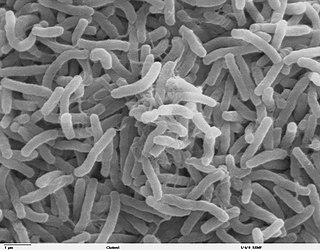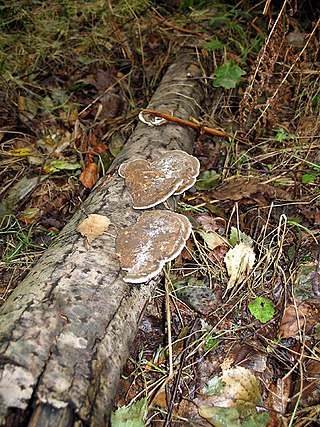See also
- Foliicolous, lichens or bryophytes that grow on leaves
- Epiphyte
- Endosymbiont
- Epilith, an organism that grows in a rock
- Epibiont, an organism that grows on another life form
- Epiphytic bacteria
- Mycorrhiza
An epiphytic fungus is a fungus that grows upon, or attached to, a living plant. The term epiphytic derives from the Greek epi- (meaning 'upon') and phyton (meaning 'plant').
Many examples of epiphytic microorganisms exist. [1] The ergoline alkaloids found in Convolvulaceae are produced by a seed-transmitted epiphytic clavicipitaceous fungus . [2]

An endosymbiont or endobiont is any organism that lives within the body or cells of another organism most often, though not always, in a mutualistic relationship. This phenomenon is known as endosymbiosis. Examples are nitrogen-fixing bacteria, which live in the root nodules of legumes, single-cell algae inside reef-building corals and bacterial endosymbionts that provide essential nutrients to insects.

A microorganism, or microbe, is an organism of microscopic size, which may exist in its single-celled form or as a colony of cells.

An epiphyte is a plant or plant-like organism that grows on the surface of another plant and derives its moisture and nutrients from the air, rain, water or from debris accumulating around it. The plants on which epiphytes grow are called phorophytes. Epiphytes take part in nutrient cycles and add to both the diversity and biomass of the ecosystem in which they occur, like any other organism. They are an important source of food for many species. Typically, the older parts of a plant will have more epiphytes growing on them. Epiphytes differ from parasites in that they grow on other plants for physical support and do not necessarily affect the host negatively. An organism that grows on another organism that is not a plant may be called an epibiont. Epiphytes are usually found in the temperate zone or in the tropics. Epiphyte species make good houseplants due to their minimal water and soil requirements. Epiphytes provide a rich and diverse habitat for other organisms including animals, fungi, bacteria, and myxomycetes.

Convolvulaceae, commonly called the bindweeds or morning glories, is a family of about 60 genera and more than 1,650 species. These species are primarily herbaceous vines, but also include trees, shrubs and herbs. The tubers of several species are edible, the best known of which is the sweet potato.

Commensalism is a long-term biological interaction (symbiosis) in which members of one species gain benefits while those of the other species neither benefit nor are harmed. This is in contrast with mutualism, in which both organisms benefit from each other; amensalism, where one is harmed while the other is unaffected; and parasitism, where one is harmed and the other benefits.

A lichen is a composite organism that arises from algae or cyanobacteria living among filaments of multiple fungi species in a mutualistic relationship. Lichens are important actors in nutrient cycling and act as producers which many higher trophic feeders feed on, such as reindeer, gastropods, nematodes, mites, and springtails. Lichens have properties different from those of their component organisms. They come in many colors, sizes, and forms and are sometimes plant-like, but are not plants. They may have tiny, leafless branches (fruticose); flat leaf-like structures (foliose); grow crust-like, adhering tightly to a surface (substrate) like a thick coat of paint (crustose); have a powder-like appearance (leprose); or other growth forms.

The germ theory of disease is the currently accepted scientific theory for many diseases. It states that microorganisms known as pathogens or "germs" can cause disease. These small organisms, too small to be seen without magnification, invade humans, other animals, and other living hosts. Their growth and reproduction within their hosts can cause disease. "Germ" refers to not just a bacterium but to any type of microorganism, such as protists or fungi, or other pathogens that can cause disease, such as viruses, prions, or viroids. Diseases caused by pathogens are called infectious diseases. Even when a pathogen is the principal cause of a disease, environmental and hereditary factors often influence the severity of the disease, and whether a potential host individual becomes infected when exposed to the pathogen. Pathogens are disease-carrying agents that can pass from one individual to another, both in humans and animals. Infectious diseases are caused by biological agents such as pathogenic microorganisms as well as parasites.

Corn smut is a plant disease caused by the pathogenic fungus Ustilago maydis. One of several cereal crop pathogens called smut, the fungus forms galls on all above-ground parts of corn species such as maize and teosinte. The infected corn is edible; in Mexico, it is considered a delicacy called huitlacoche, often eaten as a filling in quesadillas and other tortilla-based foods, as well as in soups.

Decomposers are organisms that break down dead or decaying organisms; they carry out decomposition, a process possible by only certain kingdoms, such as fungi. Like herbivores and predators, decomposers are heterotrophic, meaning that they use organic substrates to get their energy, carbon and nutrients for growth and development. While the terms decomposer and detritivore are often interchangeably used, detritivores ingest and digest dead matter internally, while decomposers directly absorb nutrients through external chemical and biological processes. Thus, invertebrates such as earthworms, woodlice, and sea cucumbers are technically detritivores, not decomposers, since they are unable to absorb nutrients without ingesting them.

Ergoline is a chemical compound whose structural skeleton is contained in a variety of alkaloids, referred to as ergoline derivatives or ergoline alkaloids. Ergoline alkaloids, one being ergine, were initially characterized in ergot. Some of these are implicated in the condition ergotism, which can take a convulsive form or a gangrenous form. Even so, many ergoline alkaloids have been found to be clinically useful. Annual world production of ergot alkaloids has been estimated at 5,000–8,000 kg of all ergopeptines and 10,000–15,000 kg of lysergic acid, used primarily in the manufacture of semi-synthetic derivatives.

Lithophytes are plants that grow in or on rocks. They can be classified as either epilithic or endolithic; epilithic lithophytes grow on the surfaces of rocks, while endolithic lithophytes grow in the crevices of rocks. Lithophytes can also be classified as being either obligate or facultative. Obligate lithophytes grow solely on rocks, while facultative lithophytes will grow partially on a rock and on another substrate simultaneously.

An endophyte is an endosymbiont, often a bacterium or fungus, that lives within a plant for at least part of its life cycle without causing apparent disease. Endophytes are ubiquitous and have been found in all species of plants studied to date; however, most of the endophyte/plant relationships are not well understood. Some endophytes may enhance host growth and nutrient acquisition and improve the plant's ability to tolerate abiotic stresses, such as drought, and decrease biotic stresses by enhancing plant resistance to insects, pathogens and herbivores. Although endophytic bacteria and fungi are frequently studied, endophytic archaea are increasingly being considered for their role in plant growth promotion as part of the core microbiome of a plant.

Catopsis berteroniana, commonly known as the powdery strap airplant or the lantern of the forest, is an epiphytic bromeliad thought to be a possible carnivorous plant, similar to Brocchinia reducta, although the evidence is equivocal. Its native range is from southern Florida to southern Brazil. It generally grows on the unshaded twigs of trees, and has been shown experimentally to trap more insects in its tank than other bromeliads of comparable size. There are several other species in the genus, none of which is believed to be carnivorous.
In agriculture and gardening, a beneficial organism is any organism that benefits the growing process, including insects, arachnids, other animals, plants, bacteria, fungi, viruses, and nematodes. Benefits include pest control, pollination, and maintenance of soil health. The opposite of beneficial organisms are pests, which are organisms deemed detrimental to the growing process. There are many different types of beneficial organisms as well as beneficial microorganisms. Also, microorganisms have things like salt and sugar in them. Beneficial organisms include but are not limited to: Birds, Bears, Nematodes, Insects, Arachnids, and fungi. The ways that birds and bears are considered beneficial is mainly because they consume seeds from plant and spread them through feces. Birds also prey on certain insects that eat plants and hinder them from growing these insects are known as non beneficial organisms. Nematodes are considered beneficial because they will help compost and provide nutrients for the soil the plants are growing in. Insects and arachnids help the growing process because they prey on non beneficial organisms that consume plants for food. Fungi help the growing process by using long threads of mycelium that can reach very long distances away from the tree or plant and bring water and nutrients back to the tree or plant roots.

Myrmecodia is a genus of epiphytic myrmecophytes, native to Southeast Asia and present in Indochina, Malaysia, the Southwest Pacific, the Philippines, and extending south to Fiji and Cape York in Queensland, Australia. It is one of five ant-plant genera in the family Rubiaceae, the others being Anthorrhiza, Hydnophytum, Myrmephytum, and Squamellaria.

Epichloë is a genus of ascomycete fungi forming an endophytic symbiosis with grasses. Grass choke disease is a symptom in grasses induced by some Epichloë species, which form spore-bearing mats (stromata) on tillers and suppress the development of their host plant's inflorescence. For most of their life cycle however, Epichloë grow in the intercellular space of stems, leaves, inflorescences, and seeds of the grass plant without incurring symptoms of disease. In fact, they provide several benefits to their host, including the production of different herbivore-deterring alkaloids, increased stress resistance, and growth promotion.

An epibiont is an organism that lives on the surface of another living organism, called the basibiont. The interaction between the two organisms is called epibiosis. An epibiont is, by definition, harmless to its host. In this sense, the interaction between the two organisms can be considered neutralistic or commensalistic; as opposed to being, for example, parasitic, in which case one organism benefits at the expense of the other, or mutualistic, in which both organisms obtain some explicit benefit from their coexistence. These organisms have evolved various adaptations to exploit their hosts for protection, transportation, or access to resources. Examples of common epibionts are bacteria, barnacles, remoras, and algae, many of which live on the surfaces of larger marine organisms such as whales, sharks, sea turtles, and mangrove trees.
The mycorrhizosphere is the region around a mycorrhizal fungus in which nutrients released from the fungus increase the microbial population and its activities. The roots of most terrestrial plants, including most crop plants and almost all woody plants, are colonized by mycorrhiza-forming symbiotic fungi. In this relationship, the plant roots are infected by a fungus, but the rest of the fungal mycelium continues to grow through the soil, digesting and absorbing nutrients and water and sharing these with its plant host. The fungus in turn benefits by receiving photosynthetic sugars from its host. The mycorrhizosphere consists of roots, hyphae of the directly connected mycorrhizal fungi, associated microorganisms, and the soil in their direct influence.
Epiphytic bacteria are bacteria which live non-parasitically on the surface of a plant on various organs such as the leaves, roots, flowers, buds, seeds and fruit. In current studies it has been determined that epiphytic bacteria generally don't harm the plant, but promote the formation of ice crystals. Some produce an auxin hormone which promotes plant growth and plays a role in the life cycle of the bacteria.
Orchid mycorrhizae are endomycorrhizal fungi which develop symbiotic relationships with the roots and seeds of plants of the family Orchidaceae. Nearly all orchids are myco-heterotrophic at some point in their life cycle. Orchid mycorrhizae are critically important during orchid germination, as an orchid seed has virtually no energy reserve and obtains its carbon from the fungal symbiont.